
Characters Other People Locations Symbols and Script Equipment Other Images Abramsverse Discoverse
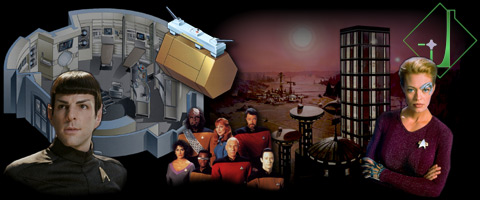
Here are various pictures of characters, species, equipment and places in Star Trek - scans, digital photos and HD screen caps. You can find more pictures of people, places and props in the richly illustrated Investigations section. If you are looking for starships, please go to the Starship Gallery .

Random Page
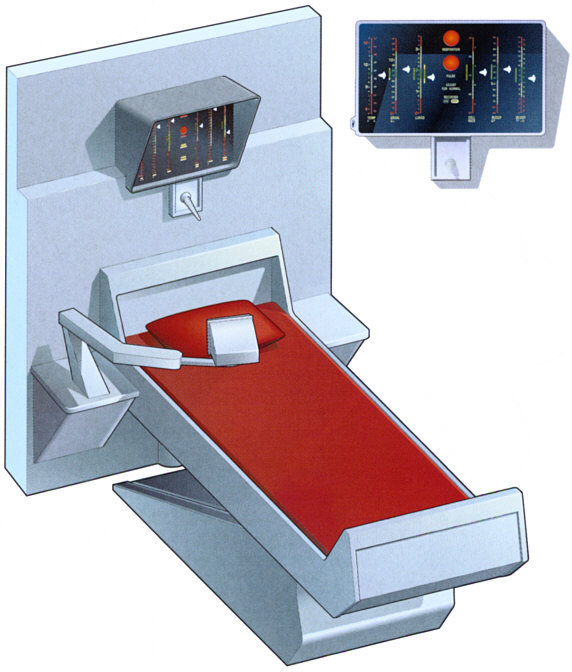
Pages with Recent Changes
- Galleries - Earth and Federation Interface... 23 Mar 2024
- Galleries - Enterprise-D Interiors 24 Feb 2024
- Galleries - Bridge Photos 24 Feb 2024
- Galleries - Alpha and Beta Quadrant Interf... 19 Feb 2024
- Galleries - Various Scenes 19 Feb 2024
- Galleries - DS9 Recurring Characters 16 Feb 2024
- Galleries - Strange New Worlds Sets and Props 14 Jan 2024
- Galleries - Other Important Races 31 Dec 2023
- Galleries - Humans 30 Dec 2023
- Galleries - VOY Main Characters 30 Dec 2023
- Galleries - Planets and Cities 30 Dec 2023
- Galleries - Delta Quadrant Races 30 Dec 2023
- Galleries - ENT Main Characters 20 Nov 2023
- Galleries - Behind the Scenes 20 Nov 2023
- Galleries - Klingons 20 Nov 2023
- Galleries - TOS Main Characters 20 Nov 2023
- Galleries - Borg 20 Nov 2023
- Galleries - Other Federation Members 20 Nov 2023
- Galleries - Discovery Sets and Props 07 Oct 2023
- Galleries - Other Lifeforms 04 Oct 2023
Starship Gallery
Investigations
TOS Main Characters - Kirk, Spock, McCoy, Scotty, Uhura, Sulu, Chekov, Chapel, Rand
Spock Moments - memories of Leonard Nimoy as Spock from TOS, movies, TNG and Abramsverse
Remembering Grace Lee Whitney - screen caps of Janice Rand from TOS, movies and Voyager
Remembering Nichelle Nichols - screen caps of Uhura from all TOS episodes and movies
TNG Main Characters, Part 1 - Picard, Riker, Data
TNG Main Characters, Part 2 - Worf, Troi, Dr. Crusher, La Forge, Yar, W. Crusher

Remembering René Auberjonois - screen caps of René Auberjonois from DS9, movies and Enterprise
A Tribute to Aron Eisenberg - screen caps of Aron Eisenberg as Nog and in other roles
VOY Main Characters - Janeway, Chakotay, Tuvok, Doctor, Seven, Kim, Torres, Paris, Neelix, Kes
ENT Main Characters - Archer, T'Pol, Tucker, Phlox, Sato, Mayweather, Reed
Other People
Other Important Races - Romulans, Bajorans, Cardassians, Ferengi, Ba'ku and Son'a, Suliban, Xindi
Other Alpha and Beta Quadrant Races
Gamma Quadrant Races
Unidentified Humanoids
Other Lifeforms - superior, minor, artificial lifeforms
Starfleet Bridge Illustrations
Alien Bridge Illustrations
Bridge Photos
Original Enterprise Interiors - incl. refit and Enterprise-A
Enterprise-D Interiors
Other Starfleet Ship Interiors
Alien Starship Interiors
Other Rooms - incl. Deep Space 9 and other space stations
Planets and Cities
Symbols and Script
22nd & 23rd Century Starfleet Uniforms - incl. badges, ranks, spacesuits
24th Century Starfleet Uniforms - incl. badges, ranks, spacesuits
Starfleet Weapons
Alien Weapons
Starfleet Communicators and Computers
Alien Communicators and Computers
Starfleet Medical Equipment
Other Starfleet Equipment
Other Alien Equipment
Various Objects - art, bottles, containers, holograms, etc.
Other Images
Abramsverse.
Abramsverse Characters
Abramsverse Sets and Props
Discovery Characters
Discovery Sets and Props
Each image in this gallery is individually attributed. Many are from legacy print publications such as The Art of Star Trek , the Star Trek Fact Files , Star Trek: The Magazine, or STTNG: The Continuing Mission . Some of the newer ones are publicity photos released by the studio. Please contact me, if other sources have to be credited. No infringement upon Paramount's or third-party copyright is intended.
https://www.ex-astris-scientia.org/gallery.htm
Last modified: 18 Feb 2024

© Ex Astris Scientia 1998-2024, Legal Terms
This website is not endorsed, sponsored or affiliated with CBS Studios Inc. or the Star Trek franchise.
Fleet Yards

Star Trek Logos: Major Galactic Powers
Artwork by Kris Trigwell
Screen Rant
Star trek: 15 alien races you need to know about.
Not all of them have bumpy foreheads. From the Ferengi to the Gorn, find out which Star Trek aliens stand out from the crowd.
While we here in the past are still waiting for our first confirmed encounter with extraterrestrial life, Star Trek predicts that the future will be teeming with lifeforms of all shapes and sizes. Some have gone to war against Earth, others have joined us in the United Federation of Planets, and still others lie undiscovered in the depths of the furthest galaxies. While some fans have accused Star Trek of only offering humanoids with bumpy faces, in reality, Gene Rodenberry and subsequent creators have gifted the world with an amazing variety of disparate cultures, beings, and societies; some odder than others.
Most of the Star Trek movies have used the alien races introduced in the TV series as a springboard to launch their stories upon, though one of the interesting things that Star Trek Beyond is doing is bringing the classic crew somewhere new: an undiscovered alien world, one we've never seen before, where they will be challenged by a new alien species that has never appeared in Star Trek canon to date.
But in order to get a handle on what's coming up soon, it's important to first understand the past , and to know how it might impact this new adventure for the Enterprise. Read on to learn all about 15 Alien Races From Star Trek That You Need To Know About.
15. The Swarm
Okay, so we don't yet know a lot about the new bad guys in Star Trek Beyond , since they've only been teasing us with little bits and pieces of information. What we do know is that their leader appears to be a figure named Krall , played by Idris Elba (of the upcoming The Dark Tower ), and he appears to have some reptilian traits. There was at one point online speculation that Krall may be a Gorn or a Cardassian, though it has been confirmed that he is the leader of a brand new race of aliens. Though this new race has not yet been identified, Zoe Saldana has revealed that the cast and crew refer to them as "the Swarm." Whether or not this name is part of the movie, or whether this "Swarm" is from one planet or perhaps an army assembled from multiple worlds, is not yet clear.
What we do know is that Krall has some serious beef with the Federation, a deep hatred with their way of doing things, though his motivations are at this point mysterious. Krall, and one would assume his "Swarm," believe strongly in independence, and are against the unification that the Federation represents. Whether his issues stem from tragedy or pure xenophobia will be revealed soon , and we're looking forward to finding out.
First introduced in the original series, the green-skinned Orions are mostly known for their so-called "slave girls," women who are known and sought after throughout the universe for their ability to release pheromones that are impossible for men to resist, and have been known to induce delusions, aggression, and increasingly low inhibitions. For the most part, Orion society has been shown to be cunning, opportunistic and often involved in black market activities, including the slave trade.
The big secret of Orion culture, however, is that despite what appearances may suggest, these female pheromones have actually turned their men into the real slaves, while women rule. The façade of Orion slave girls is maintained for the sake of advantageously using the women's power, wherein the women "sell" themselves as slaves only to use their mind-altering pheromones to enslave the powerful men of other worlds, and commercially exploit them for their money, trade, and businesses.
13. Bajorans
The Bajorans, who first appeared in Star Trek: Next Generation and went on to play a central role in Deep Space Nine , are a deeply spiritual people hailing from the planet Bajor. Their religion centers around gods that they call the Prophets — timelss beings that are often referred to by non-Bajorans as the "wormhole aliens," after Benjamin Sisko discovers them inside the wormhole — and they go to great lengths to follow what they believe to be the will of the Prophets. The dangling earrings that Bajorans wear on their right ears are a symbol of their faith, and this shared spirituality is a unifying force on Bajor.
Bajor's history is darkened by the invasion of the Cardassians, a militant reptilian race that overthrows the Bajorans goes on to occupy their planet for 50 years. During this "occupation," the entire Bajoran population is reduced to slaves, most of them forced to work in dangerous mines with many fatalities, while others spend decades actively rebelling against their Cardassian masters. Eventually, Bajor is freed from Cardassian control, but the irreversible damage to their culture and way of life is extensive.
When it comes to Star Trek aliens, there is probably no species we know less about than the Q. Seemingly an immortal, omnipotent race of beings that belong to a dimension that, at least in human language, they call the "Q Continuum," the Q have demonstrated an ability to move freely through time, instantaneously create, transform, or eliminate matter, and teleport to any location; essentially, we're talking about a race of godlike beings that is to humanity what we are to ants, and demonstrates a similarly apathetic attitude towards our wars, conflicts, and tragedies.
Considering the Q possess such an enormous awareness and control over all time and space, it's rather ironic that the only Q we've ever seen a great deal of — who, like all other Qs, goes by the name Q — is a rather irresponsible fellow played by John De Lancie. This Q often meddles in the affairs of the Enterprise, particularly during the years wherein Captain Picard is in command, seemingly for his own amusement, as the life of an all-powerful being evidently gets rather boring.
Luckily, he does seem to have the human race's best intentions in mind. Or so we hope.
11. Romulans
Originating from a common ancestry with the Vulcans, the Romulans are everything that their cool-tempered, logical counterparts are not. Fiery-tempered, emotional, and passionate about their causes, the Romulans have often been pitted against the Federation due to their feelings of superiority, and their contempt for the Vulcans.
Romulans have almost always remained an enemy to Starfleet since its earliest days, even as the Federation's relations to races like the Klingons have warmed over with time, largely due to the fact that Earth aligns itself so closely with Vulcan. Romulans have generally played a somewhat less antagonistic role than more actively destructive races like the Borg, though the time-traveling Romulan known as Nero, picture above, is the villain of the 2009 Star Trek reboot , and he does plenty of damage.
10. Andorians
Though one of the founding members of the United Federation of Planets, the Andorians are at first extremely suspicious of other races, particularly the Vulcans, though these issues are resolved over time. Andorians belong to a highly militaristic society that possesses no "stun" settings on their weaponry, and is not particularly charitable unless it suits their purposes. Nonetheless, Andorians live by a code of honor, despising dishonesty, never getting involved in fights without a good reason, and they honor their traditions very seriously; if an Andorian is injured away from Andoria, one of their comrades will deliver some of their blood back to their icy home.
Though Andorians are easily recognized by their forehead antenna and blue skin, there is actually a subspecies of Andorian called the Aenar, which possesses white skin and psychic abilities, though they are also blind. The more you know.
9. Tholians
One of the weirder alien races that the Federation has come into contact with are the Tholians, a race of arachnid-like hermaphrodites with an extremely hostile opinion of other races. Though their xenophobic ways mean that little is known about their culture, they have been demonstrated as being excessively territorial, violent, and likely to kill anyone who intrudes upon the boundaries of their home system. No wonder we haven't seen them much...
Tholians are about the same height as an adult human, standing on six legs. They possess a hard exoskeleton instead of flesh, with some sort of visible energy moving about underneath. They require a high temperature of about 404 °F to properly function, and going beneath these temperatures for any extended length of time will cause their shells to crack. Their silk is a valuable commodity across the universe, but exceptionally rare, considering the enormous difficulty of attempting to conduct business with a creature as unpleasant as a Tholian.
8. The Gorn
A race of aliens both beloved by fans and deeply underrepresented within Star Trek canon itself is the Gorn. A scaly, sharp-toothed species that resemble man-sized dinosaurs, the Gorn have so far only appeared in two episodes ever , but have never been forgotten by fandom. The lovable rubber costume probably has a lot to do with it.
The Gorn make their first appearance in an episode of the original series, when a race of aliens known as the Metron capture the captains of both the Enterprise and a Gorn ship, and force the two captains to fight to the death . Though the Gorn captain is more powerful than Kirk , the Captain still manages to outwit his reptilian counterpart, though he refuses to lay the killing blow out of mercy for the alien lying defeated before him.
Since then, the only Gorn appearance that has occurred was in a Mirror Universe episode of Enterprise , which recreated the fan-favorite creature in CGI. As stated earlier, there were some rumors that Krall in Star Trek Beyond may be a Gorn, but those have since been confirmed to be false, and a Gorn cameo was cut from the 2009 film. Someday the Gorn will finally get their day in the sun...perhaps on the small screen ?
In the future that Star Trek presents, the human race no longer needs nor uses money, as the problems of limited resources have been solved, replicators are everywhere, and Earth's society has replaced the drive for profit with the desire for union and multicultural growth. However, not all races are quite so high-minded.
The craftiest businessmen in the known universe are without a doubt the Ferengi, a race of profit-minded, greedy humanoids who, instead of following the morality-based laws of other worlds, instead go by what they call the "Rules of Acquisition." Ferengi view the pursuit of profit as the only true purpose of life, and are unadulterated capitalists who love nothing better than getting a good deal. These two hundred and eighty five rules are the sacred foundation upon which Ferengi culture is based, though the title is merely a clever marketing ploy, since the "rules" are actually nothing more than suggestions. The Ferengi unsurprisingly have a deep loathing for such things as sick leave, overtime pay, labor unions, or anything that prevents them from exploiting their workers to the maximum extent, though most Ferengi tend to accept this, since they intend to one day create their own businesses and exploit their own workers in the same way.
Star Trek writers have stated that, in contrast to the altruistic future humans that we see in Star Trek , the Ferengi are meant to represent what the somewhat less-altruistic, profit-driven humans of the 20th century are really like. Once you see it, you can't un-see it...
6. Cardassians
The Cardassians are among the most complicated of all Star Trek villains, their violent occupation and enslavement of Bajor often being seen as analogous to Nazi Germany in WWII, or the Soviet Union. Once a peaceful, artistic, and spiritual race much like the Bajorans, Cardassian culture was destroyed by the planet's lack of natural resources, causing widespread famine, which led to the rise of a military dictatorship that has lasted ever since. The Cardassian's intelligence organization, the Obsidian Order, is observed to be "one of the most brutally efficient in the galaxy," with an observation program that monitors all Cardassian citizens to ensure that they stay loyal to the state — and making sure that anyone who isn't loyal disappears without a trace.
Cardassian society is a totalitarian police state that rewards military achievements, total government loyalty, and fastidious record-keeping, with a legal system in which all suspects are immediately deemed guilty, sentenced to either death or a labor camp, and only given a "Conservator" -- not to argue their case, but instead to prepare the accused criminal to make a moving confession of guilt which will be televised live.
Cardassians are one of the primary antagonists of Deep Space Nine , a series takes place in a formerly-Cardassian space station outside Bajor after the end of the Cardassian occupation. They are the primary villains of the early seasons, often interacting with the Federation in uneasy ways, until a deeper plunge into the wormhole reveals a greater threat on the other side...
5. The Dominion
In the Gamma Quadrant, law and order is enforced by a millennia-old superpower known as the Dominion. The Dominion comprises a vast number of planets and species, all under the control of the ancient beings known the Founders, a race of liquefied entities from the Great Link, seen above, who possess the capability to shapeshift into any form. Two thousand years ago, the Founders faced persecution from the humanoid races, which they refer to as solids . To protect themselves, they genetically engineered two slave races — the Jem'Hadar, to act as their foot soldiers, and the Vorta, to be their scientists and diplomats — and once unified, the Dominion's power came to be so great that it overtook their entire section of the galaxy.
The Dominion's goal is to enforce order upon a universe they believe to be chaotic, even if it means subverting entire populations to their rule. In many ways, the Dominion is like an anti-Federation: a union of multiple worlds and populations unified not by hope, but by fear of punishment.
Cold, logical, analytical and brilliant, the Vulcans have been a key component in Star Trek since the very first episode, and are the first alien race that humanity ever comes into contact with. The most defining characteristic of Vulcan culture is its utter suppression of emotions; while Vulcans are as capable of extreme emotions as humans, they practice a rationalist lifestyle wherein logic is valued, and all emotions must be purged. This philosophy was started by the Vulcan philosopher Surak, who lived in a time of massive civil wars and bloodshed. Surak's controversial ideas regarding the value of logic and the suppression of emotion led Vulcan culture through the so-called "Time of Awakening," and was fundamental in instilling in them the logical outlook that they are known for .
Vulcans have telepathic abilities, and are able to sense massive events that occur to the Vulcan population. These abilities are strengthened by physical contact, leading to the famous Vulcan mind meld, wherein a Vulcan can share their thoughts, experiences, and memories with another individual of almost any species.
Perhaps the most dehumanizing of all alien threats , the Borg is the name given to a single collective consciousness spread across an entire intergalactic network of cyborgs -- driven by the need for self-perfection -- that assimilates other species into themselves through the use of cybernetic implants. Like an ant colony, all serving the Borg Queen, the Borg themselves do not have individuals amongst them, nor culture, and never strive to do anything outside of serving the hive mind that they all share.
Many cultures, worlds, types of technology, and entire alien races have all been unwillingly overtaken by the Borg, who indiscriminately absorb adults, children, infants, and technology into their collective mind and body, stripping away all traces of free will, while simultaneously taking in any unique genetic and/or technologic progress, thereby allowing them to constantly adapt and change. However, the Borg have demonstrated a complete disinterest in assimilating races that they deem "unworthy," which is one of their few blind spots.
Due to their omnivorous nature, the Borg includes the assimilated bodies and minds of many Vulcans, Klingons, Romulans, humans, and anything else that is unlucky enough to cross their path.
2. Klingons
Like Vulcans, the Klingons are one of the alien races most immediately identifiable with Star Trek , possessing the sort of unique cultural identity and history that makes the Star Trek universe so broad and fascinating. The Klingon language has been assessed by Guinness World Records as being the most popular fictitious language in the world, and there are entire works of William Shakespeare have been translated to Klingon. When it comes to cultural impact, that's hard to beat.
Originally presented as antagonists, and later allies of the Federation, the Klingons are a race of warrior conquerors that value honor above all else. Blunt and aggressive, with no room for subtleties or debate, Klingons tend to know what they want, but should not be mistaken for savages. Klingons are a society that idealizes war and combat, but much like the Vikings of outer space, they are also a deeply religious people who make great efforts to live the sorts of lives that are deemed honorable in their culture. Klingons prefer being killed to being captured in battle, and celebrate the death of loved ones instead of mourning them, believing that to die in battle is the sort of achievement that all Klingons should strive for.
Klingons also have their own form of opera, which usually depicts tales of grim courage, honorable sacrifice, and unfulfilled love. Supposedly, Klingon opera is immensely painful for many non-Klingons to listen to.
1. Tribbles
The most adorable creature in the galaxy is certainly the Tribble, a small, furry, slow-moving creature with no external features, that emits a soft cooing sound when stroked, all of which makes them immensely endearing to humans. Klingons have a somewhat lesser opinion of the furry beings, due to the sharp allergenic reaction that Tribbles provoke in them, combined with the fact that they find their stench absolutely revolting. As a result, Klingons tend to identify Tribbles as "parasites," and have even gone so far as to call them their "mortal enemies."
Tribbles would probably make great pets, except for one major problem: they reproduce on a level that would make rabbits jealous. They're born pregnant, which is their first advantage in survival, and Tribbles reproduce so quickly that they'll quickly fill up an entire ship, requiring more and more food. Because of this, Starfleet forbids their transportation, and considers them dangerous organisms.
Like the Gorn, while Tribbles have only made a few appearances in official Star Trek lore, they're one of the most fondly remembered Trek aliens of all time. The phrase " multiplying like Tribbles " is a part of the public lexicon. A family of real-world proteins has been named after them. Not to mention, Tribble props from the show have been sold at auction for as much as $1,200. Oh, and one once helped save Kirk's life . We have to say, that's pretty good for a bunch of puffballs.
Did we forget your favorite race/species from the final frontier? Let us know in the comments.
Yournerdside.com
- Oct 3, 2023
Star Trek's Different Klingon Designs, Explained
Latest Your Nerd Side Show:
The Star Trek saga spans six decades and over 800 hours of storytelling on television and in film. While the universe created by Gene Roddenberry is vast and dynamic, the Klingons have appeared in every iteration of the franchise. Yet, since their debut in Star Trek: The Original Series in 1966, the Klingons' character design has changed over time. From regular humans with brown makeup and stylized facial hair to the intricate alien prosthetics on the characters in Star Trek: Discovery , there's more than one way to skin a Klingon.
Save for the odd standout like Khan Noonien Singh , heroes and starships are more important in Star Trek than its many villains . Instead, the alien antagonists that menace Starfleet explorers are mostly known by their species, like Romulans or the Borg. This is true of Klingons, which are immediately recognizable, though casual fans may not know General Chang from T'Kuvma. It wasn't until the debut of Star Trek: The Next Generation and Klingon bridge officer Worf that the franchise truly started to examine the culture of this war-like race. Thanks to his appearances in both Deep Space Nine and Star Trek: Picard Season 3 , Worf has appeared in more Star Trek episodes than any other character. He also laid the foundation for storytellers to create an in-narrative reason for the disparity in Klingon appearance. In the real world, the simple answer for the many different Klingon character designs comes down to money and technology.
The Klingons in Star Trek: The Original Series Were Simple on Purpose
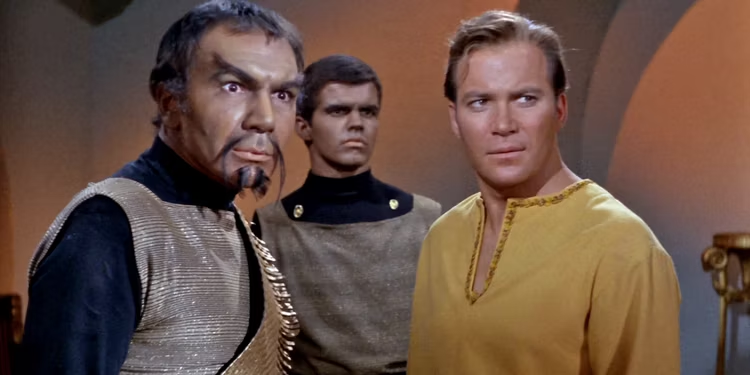
The Klingons were, effectively, created by Gene L. Coon, often called " Star Trek 's other Gene." He conceived of the characters as an allegory for the Soviet Union, according to the special features on the DVDs for Star Trek: TOS . Intended to be just one-off antagonists for the Season 1 episode, "Errand of Mercy," writer David Gerrold brought them back for Season 2's classic "The Trouble with Tribbles" episode. Crafting that story made the producers realize the Klingons could be the ongoing antagonist for Captain Kirk and the USS Enterprise crew they'd been looking for.
Despite being an expensive series, Star Trek: TOS was always struggling with budget and time. Makeup supervisor Fred Phillips worked with actor John Colicos to design the characters' look. However, outside of raised eyebrows -- similar to both Vulcans and Romulans -- and stylized facial hair, the Klingons were mostly defined by their glittery uniforms with a gold sash. The makeup process for The Original Series -era Klingons often took less time than even affixing Spock's Vulcan ears each day. The character design for early Klingons was simple and effective for TV, but that soon changed.

The Klingons Look From Star Trek: The Motion Picture Through The Next Generation Era
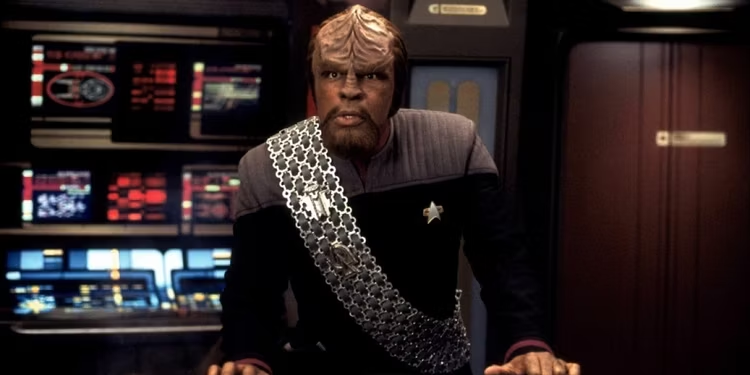
Nearly a decade after The Original Series went off-the-air, Star Trek: The Motion Picture debuted and introduced fans to a new kind of Klingons. With significantly more budget and time to work with -- the Klingons appeared in only a single scene -- Fred Phillips wanted to make the aliens truly alien. The production of the first Star Trek film was fraught, so if Gene Roddenberry had any objections to changing the Klingon character design, he had bigger battles to fight. The Klingons appeared in each successive film save for The Wrath of Khan , and while their appearance was altered slightly, they maintained the same look.
However, it wasn't until Worf was added to The Next Generation cast that Roddenberry and the writers really began to think of them as a people rather than allegorical Soviets. Now that a Klingon was a hero character, he felt it was an injustice to the characters to reduce them to just being a warrior race. "I take the fact of their fictional existence very seriously," he said in the Star Trek 25th anniversary issue of Cinefantastique . In an interview in the special features of Star Trek: TNG 's first season, actor Michael Dorn noted that Black actors were routinely cast as Klingons to simply save time in the makeup chair. Over the next 18 years, makeup supervisor Michael Westmore had to create dozens of distinct Klingon characters.
In Enterprise Season 4 , the writers addressed the incongruity of the Klingon appearance in Star Trek: TOS with the second-wave era. A storyline was introduced about a genetic modification experiment that went awry. In order to cure a deadly, multi-species virus, Klingons were given a treatment that "smoothed over" the cranial ridges and teeth added to the design to make them look more alien. Yet, even the Klingons not affected by this mutation still looked more human than not. When former Star Trek: Voyager producer Bryan Fuller wanted to redesign them for Star Trek: Discovery , making them more alien was the goal.
The Design for Klingons in Star Trek: Discovery Was Very Controversial
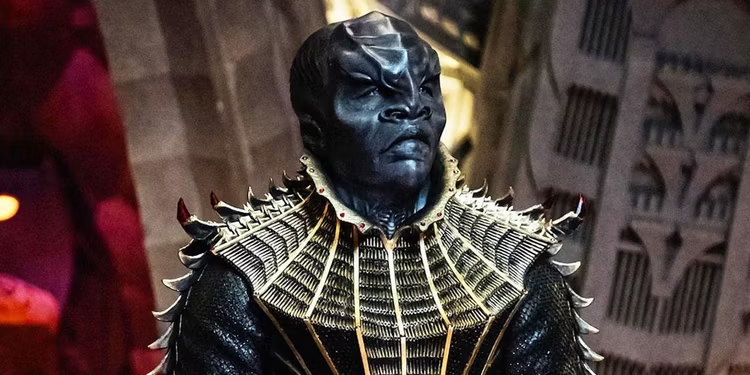
During episodes of the now-defunct After Trek webseries during Star Trek: Discovery 's first season, the Klingon redesign was an often-discussed topic. The cranial ridges and teeth Fred Phillips added during the first redesign were extended to seemingly cover their entire body. They were given longer, clawed fingers and evolutionary characteristics that were more avian or reptilian than humanoid. The hope was to make the Klingons even more alien and frightening, but the design change proved to be a bit too drastic. By Season 2, the makeup artists gave them hair again. They also introduced a number of different skin tones beyond just brown.
Yet, by Strange New Worlds Season 2, the Klingons looked more like they did during the second-wave era. Unlike Enterprise , there was no in-narrative reason or the different look. The Klingon Empire is an interstellar society with hundreds of billions of citizens. Fans can easily explain away the difference as Star Trek 's continued commitment to Roddenberry's motto of infinite diversity in infinite combinations. Klingons are also able to reproduce with other Star Trek species, which could equally explain the difference.
In both cases, the redesign of the Klingons was meant to highlight their alien nature and take advantage of state-of-the-art makeup and prosthetics. The Discovery design may have been too successful, and franchise producers seem to have reverted the iconic antagonists to their Star Trek: TNG -era design . Still, no matter what they look like, Klingons are integral to Star Trek . They are enemies who became allies, which is the lesson Roddenberry always wanted his show to teach humanity.
Recent Posts
Patrick Stewart Teases Involvement in New Star Trek Movie
Armin Shimerman Used DS9's Quark to Fix His TNG Ferengi Mistake
Lower Decks Sends Up the Beloved Picard Finale

- View history
This category encompasses all biological species that do not qualify as artificial lifeforms or belong to Category:Animals or Category:Plants .
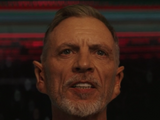
All items (627)
- Alpha and Beta Quadrant species
- Category:Animals
- Delta Quadrant species
- Category:Fungi
- Gamma Quadrant species
- Category:Genetically engineered biological lifeforms
- Humanoid species
- Category:Hybrids
- Category:Memory Alpha non-canon redirects (species)
- Non-humanoid species
- Category:Plants
- Shapeshifting species
- Spaceborne species
- Category:Unnamed species

- Boltzmann brain

- B'Saari

- Doosodarian

- More to Explore
- Series & Movies
Published Apr 10, 2024
A Brief History of the Progenitors in Star Trek
They designed life itself!
SPOILER WARNING: This article contains story details and plot points for Star Trek: Discovery 's "Red Directive ."

StarTrek.com
Captain Burnham's top-secret mission in the final season of Star Trek: Discovery has finally been revealed. But this time, the Discovery crew isn’t stopping a future-destroying A.I., or a lethal, extra-galactic force. Instead, they’re investigating the basic mysteries of why most species in the Star Trek universe look vaguely human.
As revealed in " Red Directive ," the search for technology used by ancient "Progenitors" sets-up a massive treasure hunt for the season. But, who are the Progenitors? What did Jean-Luc Picard know about the secrets of inter-species alien DNA? And how does all of this fit in with Gene Roddenberry’s earliest ideas for Star Trek ?
Here’s a brief history of the Progenitors, from the early 1960s, to the 24th Century, all the way to 2024, and the 31st Century.
The Real World-Origins of the Progenitors

"The Cage"
When the U.S.S. Enterprise first set out to seek out "new life and new civilizations," a huge swath of those alien lifeforms turned out to look a lot like human beings. And the primary reason for that, at least behind-the-scenes, was two-fold.
First, human actors are more affordable, and second, Gene Roddenberry wanted the classic Star Trek to avoid the sci-fi trope of "Bug-Eyed Monsters." And so, in one of the original 1964 pitch documents for Star Trek , Roddenberry floated the idea of "The Parallel Worlds" concept . The idea was that the format of Star Trek — from a writing and production standpoint — would generally deal with "...plant and animal life, plus people, quite similar to Earth. Social evolution will also have interesting points of similarity with ours."
Unlike a huge swath of science fiction on TV at the time, the promise of strange, new worlds, that were, in fact, populated by people , is something that set Star Trek apart, and was the cornerstone of what gave the series its humanist angle. But, the side effect of course, was an in-universe question — why were so many aliens humanoid?
The Old Ones, Sargon, and The Preservers

"The Paradise Syndrome"
The first two seasons of The Original Series are sprinkled with hints that, in the distant past, the galaxy was visited by super-powered aliens with technology far more advanced than anything in the Federation.
In " What Are Little Girls Made Of? ," we meet Ruk, an android built by "The Old Ones," an alien race capable of creating humanoid androids that were basically immortal. In " Return to Tomorrow ," the disembodied soul of Sargon, refers to humanity as "my children." While Dr. Muhuall says this idea flies in the face of evolutionary theory, Spock mentions the idea that aliens seeded life would "explain certain elements of Vulcan pre-history."
Then in Season 3, in " The Paradise Syndrome ," Bones and Spock tackle the question head-on. When they realize an ancient race of "Preservers" helped various humanoid species throughout the galaxy, the idea of an ancient alien race guiding and "seeding" a ton of humanoid species became less of a myth and more of a working theory. "I’ve always wondered why there were so many humanoids scattered through the galaxy," Bones says. To which Spock replies, "So have I. Apparently, the Preservers account for a number of them."
And then, the questions about an ancient humanoid species went answered. At least, until The Next Generation .
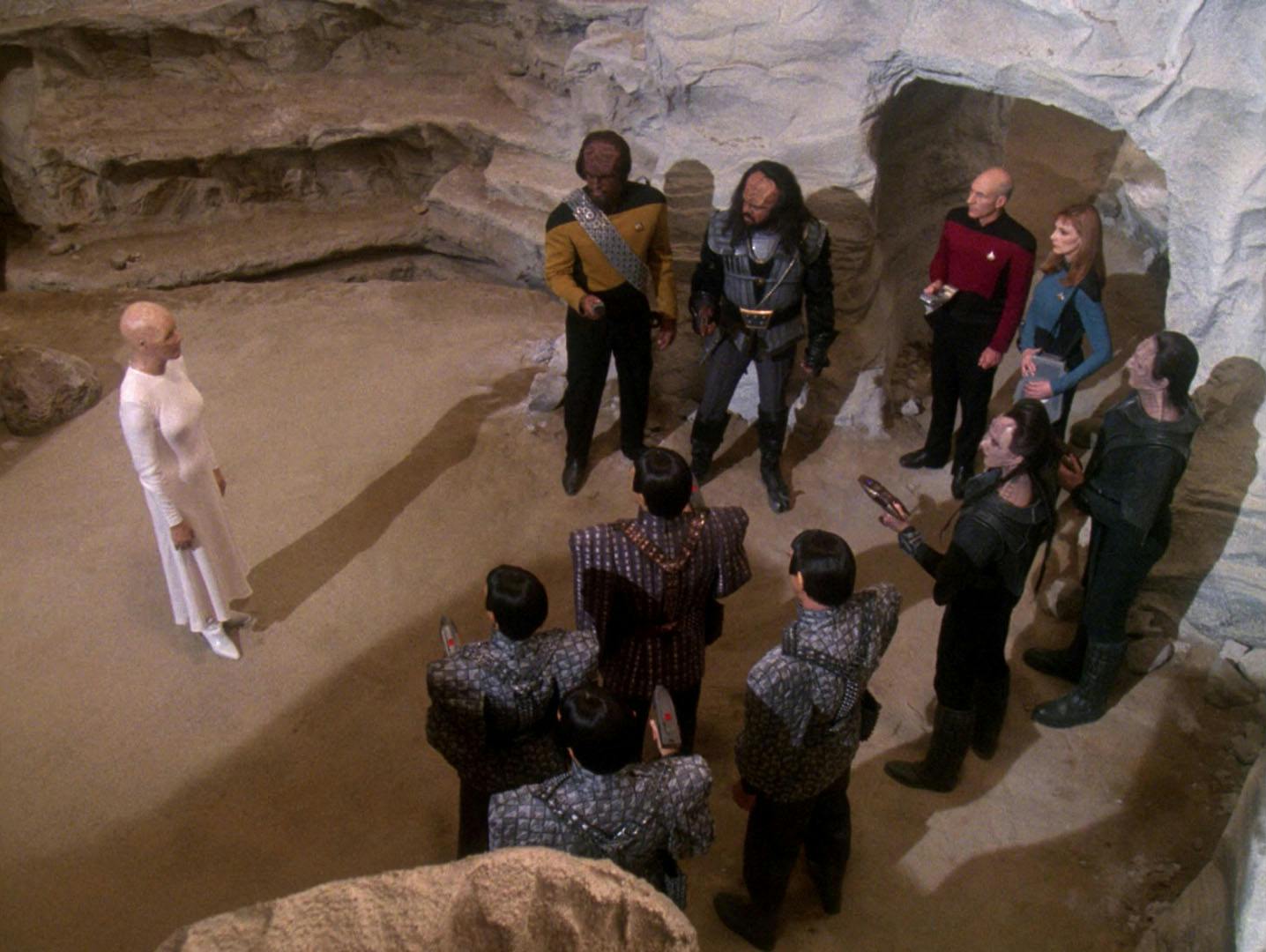
"The Chase"
Directed by Jonathan Frakes and written by Ronald D. Moore and Joe Menosky, " The Chase " was a sixth-season episode of The Next Generation , which, according to The Next Generation Companion , was considered in the writers' room the most "Roddenberryesque" episode of TNG at that time. The story itself took cues from Carl Sagan's novel Contact , and posited that yes, ancient aliens not only seeded most of the humanoid species, but also hid a message in the DNA of all those species.
Captain Picard's interest in archeology comes in handy during the quest to locate all the DNA strands and reveal the message, which was also represented metaphorically by the ancient artifact known as the Kurlan naiskos .
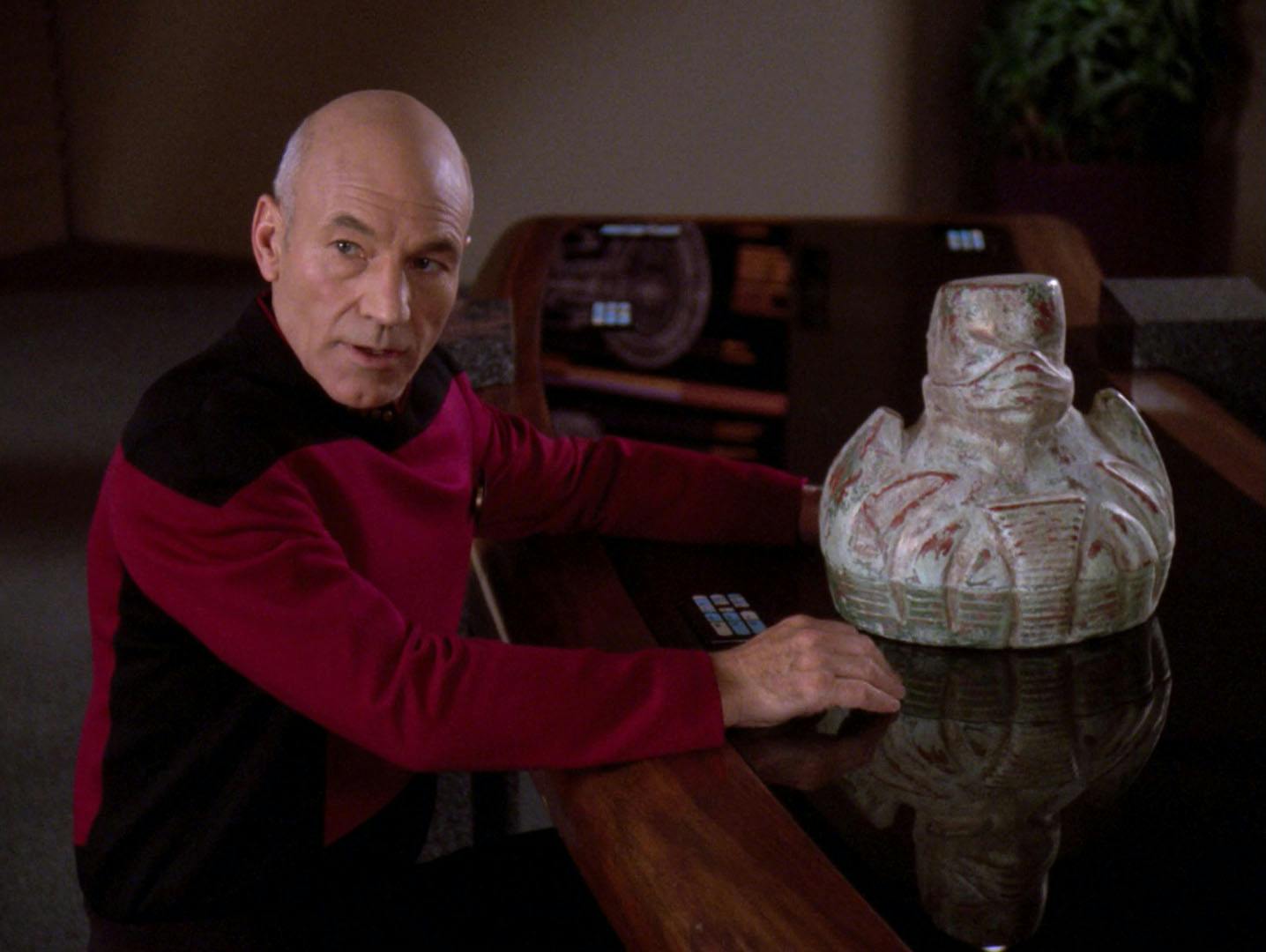
At the end of the episode, representatives from the Klingon Empire, the Romulan Empire, the Cardassian Union, and the Federation, all witness the truth — an ancient Progenitor (played by Salome Jens) makes it clear that all the humanoid species in the galaxy don’t exist out of pure hubris, but instead, out of a kind of desire for legacy. "You are a monument, not to our greatness, but to our existence…. Remember us."
Ronald D. Moore pointed out that there's no reason to believe that the Progenitors from "The Chase" and the Preservers from TOS aren't one in the same. Though not explicitly stated in the script, he said, "But this could be them, and be internally consistent."
Discovery Brings It All Home
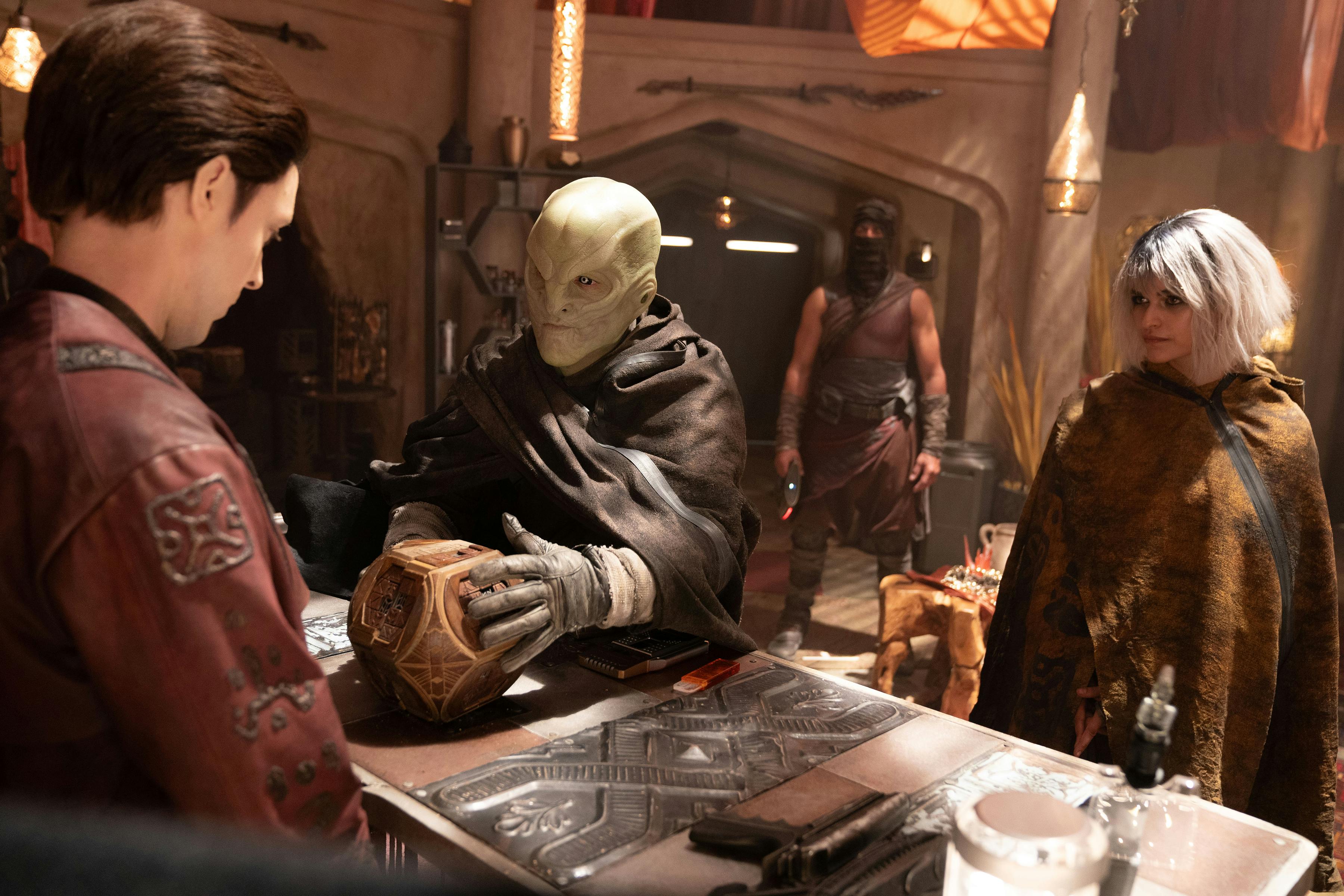
"Red Directive"
While The Next Generation established a canonical fact that TOS only danced around, that only answered the question of why . With Discovery Season 5, a stranger, and more complex question is getting broached — how ?
"The Chase" told us why there are so many humanoid species in the galaxy, but we had no idea how the Progenitors specifically pushed life to evolve on various planets toward the exact form of life we’re all so familiar with. As the crew of Discovery — and other forces — are in pursuit of this ancient tech, Star Trek is boldly speculating on one of the biggest questions of all time.
If there was a supreme intelligence behind the creation of life, what was their method? While these kinds of questions are somewhat mind-boggling in real life, what Discovery is doing now is what Star Trek has done all along: Ask provocative questions that are beyond what we know now, so that maybe, in the future, we’ll be better prepared.
We don’t know that the Progenitors exist in real science, but the "panspermia hypothesis," is a very real scientific concept. A friendly alien may not have consciously sparked life on Earth eons ago, but, in reality, it is possible that some building blocks for life itself may have come from the stars.
Get Updates By Email
Ryan Britt is the author of the nonfiction books Phasers on Stun! How the Making and Remaking of Star Trek Changed the World (2022), The Spice Must Flow: The Journey of Dune from Cult Novels to Visionary Sci-Fi Movies (2023), and the essay collection Luke Skywalker Can’t Read (2015). He is a longtime contributor to Star Trek.com and his writing regularly appears with Inverse, Den of Geek!, Esquire and elsewhere. He lives in Portland, Maine with his family.
Star Trek: Discovery Seasons 1-4 are streaming exclusively on Paramount+ in the U.S., the UK, Canada, Switzerland, South Korea, Latin America, Germany, France, Italy, Australia and Austria. Seasons 2 and 3 also are available on the Pluto TV “Star Trek” channel in Switzerland, Germany and Austria. The series streams on Super Drama in Japan, TVNZ in New Zealand, and SkyShowtime in Spain, Portugal, Poland, The Nordics, The Netherlands, and Central and Eastern Europe and also airs on Cosmote TV in Greece. The series is distributed by Paramount Global Content Distribution.
- Star Trek 101
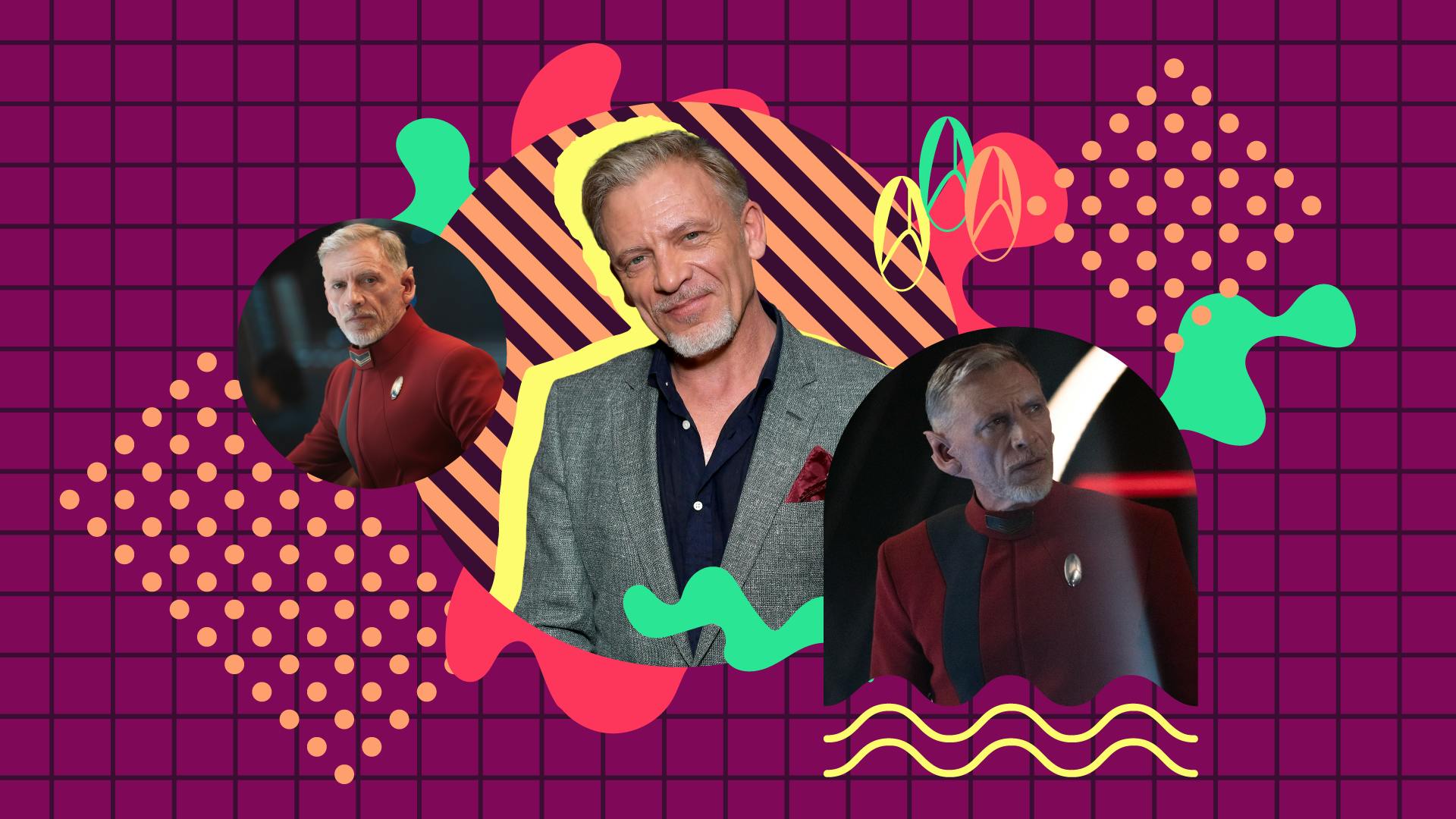


Biggest Star Trek Retcons
- Star Trek's Federation and Klingon relationship is a source of debate among fans over formal membership vs. alliance.
- The infamous Eugenics Wars conflict was pushed into the mid-21st century due to timeline discrepancies in the show.
- Klingons have undergone significant changes in appearance and behavior throughout the Star Trek franchise.
Gene Roddenberry's Star Trek franchise is full of iconic heroes, aliens, and starships. Set centuries in the future, it imagines a galaxy where the human race has abandoned its worst tendencies in favor of exploring the wonders of the galaxy . This format has proven remarkably successful, as Star Trek: The Original Series overcame initially poor odds to spawn over half a dozen spin-off series, as well as several movies and hundreds of books, comics, and video games.
Star Trek: 7 Alien Civilizations Discovered By Captain Kirk
Yet like every long-running franchise, the universe of Star Trek is full of contradictions, forgetful writers, and behind-the-scenes errors. From Spock's rapidly growing family tree to numerous issues involving the Klingons, it's safe to say that the final frontier is far from set in stone.
The Members of the Federation
How far-reaching is the utopian alliance.
Despite representing the undisputed system of government for Earth and countless other worlds, very little concrete information is divulged about the Federation and its members throughout the Star Trek franchise. The size of the alliance fluctuates wildly depending on the source consulted: while The Original Series implies that there are just over 30 worlds in the Federation, information related to the more-or-less concurrent Kelvin timeline suggests a group at least four times larger. While this discrepancy can be attributed to divergent timelines, one point of contention remains: the status of the Klingon Empire.
While it's undeniable that the Federation and the Klingon Empire were allies during The Next Generation , various set dressing details and throwaway lines hint at a deep relationship. A Klingon starship carries the Federation flag on its bridge in "Heart of Glory", perhaps implying membership, while a later conversation between Picard and Wesley Crusher is even more explicit. In "Samaritan Snare", Wesley refers to a time "before the Klingons joined the Federation". However, many fans discount this line, suggesting that it refers to the Treaty of Alliance rather than formal membership.
The Eugenics Wars
What actually happened (and when).
The infamous Eugenics Wars (first referenced in The Original Series episode "Space Seed") was a devastating conflict that killed millions and resulted in humanity abandoning its research into genetic augmentation. According to a conversation between Captain Kirk and Doctor McCoy, the conflict took place between 1992 and 1996—the distant future for viewers of the episode's original broadcast. However, given that the mid-nineties came and went without any global conflict, Star Trek 's writers have subsequently scrambled to reconcile sixties' world-building with contemporary knowledge.
Star Trek Fans Debate Who Deserves Credit For Defeating Khan
In an attempt to make sense of the timeline, Star Trek: Strange New Worlds suggested that temporal interference from various factions pushed the Eugenics War (and the actions of the genocidal Khan ) forward into the mid-twenty-first century. Whether future franchise showrunners will be forced to kick the can further down the road remains to be seen, but it certainly wouldn't be the first retcon to this vital part of Star Trek lore.
Can They Use Transporters?
The Trill are one of Star Trek 's more bizarre aliens, as some of the humanoid species are physically connected to a centuries-old symbiont. When the host dies, their memories live on within the symbiont, which is subsequently transferred into another individual. The Trill's unique physiology was central to their introductory episode "The Host", which saw Beverly Crusher fall in love with one of the aliens only for its host to tragically die.
The decision to foreground the Trill in the subsequent Star Trek: Deep Space Nine meant that the aliens underwent a radical overhaul. In The Next Generation , joined Trill were unable to use transporters because doing so would endanger their symbiont, while DS9 's Dax frequently made use of the technology. Also notable was the change in the Trill's appearance: the show's writers were apparently scandalized that the beautiful Terry Farrell would be given the Trill's original ugly makeup, and suggested using the spots previously seen on the Kriosians in The Next Generation .
Starfleet's Identity
Just who is captain kirk answerable to.
The Federation Starfleet is now so much of a part of nerd culture that the organization's chevron symbol is recognizable even outside its original context. However, both the famous insignia and the identity of Starfleet itself were once very far from concrete, as evidenced by early episodes of The Original Series . In "Charlie X", Captain Kirk makes a report to "UESPA headquarters", rather than Starfleet Command. Then, in "Tomorrow is Yesterday", the acronym is defined as referring to the United Earth Space Probe Agency, and Kirk suggests that this organization is responsible for the Enterprise 's mission.
Star Trek: Best Starships To Work On
The United Earth Space Probe Agency doesn't roll off the tongue in quite the same way as "Starfleet", so the decision to alter the name of Kirk's employers into something punchier makes a lot of sense. Interestingly, future shows did play lip service to the UESPA concept: an unmanned probe launched by the group is discovered by the USS Voyager in "Friendship One", while Star Trek: Enterprise implies that UESPA is part of Starfleet rather than a separate organization.
Spock's Family Tree
How many long-lost siblings can one vulcan have.
The Vulcan Spock may have an impeccable sense of logic, but he also appears to have a terrible memory when it comes to his own family. While this vagueness can be traced back to The Original Series (his claim that a human woman married one of his ancestors is a strange way to refer to his own mother and father), Spock is particularly susceptible to suddenly recalling previously unmentioned siblings. Star Trek V: The Final Frontier (1989) introduced audiences to estranged half-brother Sybok , while Star Trek: Discovery saddled Spock with an adopted human sister in the form of Michael Burnham.
Why the Discovery writing room decided to draw inspiration from what is widely regarded as the worst Star Trek film remains unclear—it may be that Spock is perceived to be such a cultural heavyweight that linking new characters to the original Vulcan is seen as a way to ensure their popularity. Whether this is actually accurate is up for debate, but with countless other Star Trek projects currently in development, Spock may find his family tree yielding further undisclosed branches.
The Klingons
They do not discuss their retcons with outsiders.
The Klingons are probably Star Trek 's most iconic alien race, but when it comes to internal consistency, the classic species is sorely lacking. The Original Series cast the Klingons as scheming space Soviets; The Next Generation reinvented them as honor-bound warriors . Nor do the Klingons maintain a constant appearance: they didn't grow their craggy foreheads until Star Trek: The Motion Picture (1979), while the recent Star Trek: Discovery chose to depict the Klingons as bald space orcs. While most of these changes can be attributed to behind-the-scenes budget increases, the in-universe logic is far murkier.
Star Trek: Worf's Best Quotes
Star Trek: Enterprise made a valiant effort to explain the change in Klingon appearance and behavior, only to be completely ignored by the subsequent Star Trek: Discovery . Deep Space Nine 's "Trials and Tribble-ations" perhaps puts it best—when asked why he doesn't resemble the Klingons of Kirk's era, Worf shuts down the conversation by saying that it is not a topic that they discuss with outsiders.
Created by Gene Roddenberry
First Film Star Trek: The Motion Picture
Latest Film Star Trek Beyond
First TV Show Star Trek: The Original Series
Latest TV Show Star Trek: Strange New Worlds
Creation Year 1966
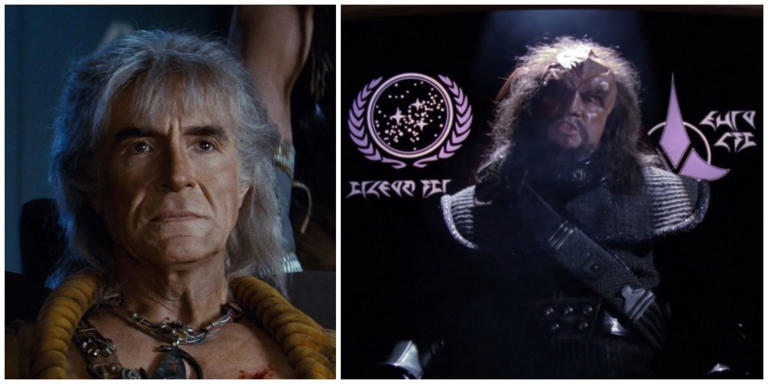

IMAGES
VIDEO
COMMENTS
Star Trek Logos and Symbols, Artwork by Kris Trigwell » Star Trek Minutiae. The talented Kristian Trigwell (aka "Reverend") spent many months researching hundreds of logos, insignia, and symbols seen in every Star Trek series and movie, and then faithfully reproduced them as vector artwork. He also included a few original designs of his own.
A species or race was any class of lifeform that had common attributes and were designated by a common name. According to Data, "in the game of military brinksmanship, individual physical prowess is less important than the perception of a species as a whole." However, according to Worf, if "no one is willing to test that perception in combat [..] then the reputation means nothing." (TNG: "Peak ...
The Borg used numerical species designations to identify various species and cultures they encountered. As part of her idolization of Seven of Nine, Naomi Wildman developed a habit of memorizing Borg species designations, something which Seven suspected her mother would not approve of. (VOY: "Survival Instinct") Though not explicitly stated, species designations are mostly consistent with ...
In the Star Trek universe, the delta emblem is a direct descendant of the vector component of the old NASA (and later UESPA) logos in use during Earth's space programs of the 20th and 21st Centuries.Those symbols were worn by some of the first space explorers and adorned uniforms and ships during humanity's first steps into the final frontier.
Characters Other People Locations Symbols and Script Equipment Other Images Abramsverse Discoverse. Here are various pictures of characters, species, equipment and places in Star Trek - scans, digital photos and HD screen caps. You can find more pictures of people, places and props in the richly illustrated Investigations section.
A collection of many logos, symbols, badges, and banners from the Star Trek universe. Artwork by Kristian Trigwell. Home; Resources; Articles; Humor; Stories; Blog; Search: Go. Star Trek Logos: Major Galactic Powers. ... The Star Trek trademarks and logos are owned by CBS Studios Inc. This website is intended for personal use only, under ...
An Orion symbol used in the 24th century. ... Orions are one of the default playable species in Star Trek Online as part of the Klingon Empire faction. The Orion government, though ostensibly neutral, is effectively a client state of the Klingon Empire. Meanwhile the Orion Syndicate purged non-Orion members and aligned fully with the Empire in ...
Star Trek has had great influence on modern culture. And no more so than its graphic design. For three generations designers have been profoundly influenced by the symbols, insignias and logos seen in Star Trek. In turn, those generations have, through design, woven aspects of the Star Trek graphic design aesthetic into every aspect of daily life.
The Cardassians (/ k ɑːr ˈ d æ s i ə n z /) are a fictional extraterrestrial species in the American science fiction franchise Star Trek.They were devised in 1991 for the series Star Trek: The Next Generation before being used in the subsequent series Star Trek: Deep Space Nine and Star Trek: Voyager.. The writers of The Next Generation introduced the Cardassians for the fourth season ...
In the TOS movies, Spock was joined by the iconic Saavik and Valeris: two of his proteges. Since then, other notable Vulcans have been integral to the adventures seen in other Star Trek series, with T'Pol in Enterprise, Tuvok in Voyager, and T'Lyn in Lower Decks. None are quite as iconic as Spock, though Tuvok probably comes closest.
Klingon. The Klingons ( / ˈklɪŋ ( ɡ) ɒn / KLING- (g)on; [2] Klingon: tlhIngan [ˈt͡ɬɪŋɑn]) are a fictional species in the science fiction franchise Star Trek . Developed by screenwriter Gene L. Coon in 1967 for the original Star Trek ( TOS) series, Klingons were swarthy humanoids characterized by prideful ruthlessness and brutality.
Join us as we explore the depths of the Star Trek universe to learn about the Ferengi, one of the most beloved and fascinating species in the franchise. From...
Star Trek. aliens. Star Trek is a science fiction media franchise that began with Gene Roddenberry 's launch of the original Star Trek television series in 1966. Its success led to numerous films, novels, comics, and spinoff series. A major motif of the franchise involves encounters with various alien races throughout the galaxy.
The Klingons (tlhIngan in Klingonese) were a humanoid warrior species that originated from the planet Qo'noS (pronounced Kronos), an M-class planet in the Beta Quadrant. One of the major powers of the galaxy, the Klingons were a proud, tradition-bound people who valued honor and combat. The aggressive Klingon culture had made them an interstellar military power to be respected and feared. Main ...
Species 2000, 3783, and 5008 are among those species, being the Cardassians, the Romulans, and the Klingons, respectively. While the explanation of how the Borg designates numbers to a certain species seems quite straightforward, some deviations may mean there's more to the numbering system than meets the eye. Keep reading to learn all you ...
StarTrek.com. Spotted on the lapel of time-traveling 29th-century Starfleet officer Captain Braxton in Voyager, this combadge shows that the Starfleet insignia truly has some staying power. Of course, the 29th century was previously the farthest ahead we've ever gotten in the Trek timeline, but with the upcoming season of Discovery we'll ...
8. The Gorn. A race of aliens both beloved by fans and deeply underrepresented within Star Trek canon itself is the Gorn. A scaly, sharp-toothed species that resemble man-sized dinosaurs, the Gorn have so far only appeared in two episodes ever, but have never been forgotten by fandom.
The Design for Klingons in Star Trek: Discovery Was Very Controversial. During episodes of the now-defunct After Trek webseries during Star Trek: Discovery's first season, the Klingon redesign was an often-discussed topic. The cranial ridges and teeth Fred Phillips added during the first redesign were extended to seemingly cover their entire body.
This category encompasses all biological species that do not qualify as artificial lifeforms or belong to Category:Animals or Category:Plants.
Captain Burnham's top-secret mission in the final season of Star Trek: Discovery has finally been revealed. But this time, the Discovery crew isn't stopping a future-destroying A.I., or a lethal, extra-galactic force. Instead, they're investigating the basic mysteries of why most species in the Star Trek universe look vaguely human.. As revealed in "Red Directive," the search for ...
The Vulcan salute is a hand gesture popularized by the 1960s television series Star Trek. It consists of a raised hand with the palm forward and the thumb extended, while the fingers are parted between the middle and ring finger. The gesture was devised by Star Trek actor Leonard Nimoy as a salute for the alien Vulcan species, and is popular ...
Home; Symbols ©2024 Star Trek Design Project. All rights reserved. Committed to WCAG 2.1 AA Accessibility Compliance.
The Trill are one of Star Trek's more bizarre aliens, as some of the humanoid species are physically connected to a centuries-old symbiont. When the host dies, their memories live on within the ...